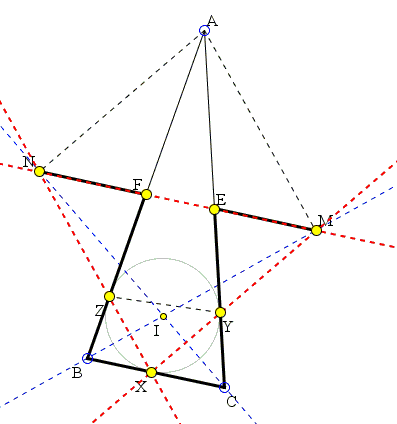A Triangle of Antreas Hatzipolakis
| What if applet does not run? |
In ΔABC, D, E, F are the midpoints of sides BC, AC, and AB, while X, Y, Z are the points of tangency of the incircle with those sides. Let M be the foot of the perpendicular from A to BI and N the foot of the perpendicular from A to CI. Then
- Points M, N, E, F are collinear,
- Points X, Y, M are collinear, as are the points X, Z, N.
|Activities| |Contact| |Front page| |Contents| |Geometry|
Copyright © 1996-2018 Alexander Bogomolny
By the construction, ΔABM is right with
AF = BF = FM.

It follows that ΔBFM is isosceles and ∠FBM = ∠FMB. Thus the sum of these angles equals ∠AFM. On the other hand, since BI bisects ∠ABC, the sum of equal angles FBM and CBM equals ∠ABC. We see that
∠AFM = ∠ABC
so that FM||BC and, since F is the midpoint of AB, FM is a midline in ΔABC and passes through another midpoint, viz., E. This shows that M lies on EF. By symmetry the same holds for N.
Further
| EM | = FM - EF | |
| = AF - EF | ||
| = AB/2 - BC/2 | ||
| = (AB - BC)/2 | ||
| = (AZ - CX)/2 | ||
| = (AY - CY)/2 | ||
| = (AC - 2·CY)/2 | ||
| = (2·EC - 2·CY)/2 | ||
| = EC - CY | ||
| = EY, |
implying that ΔMEY is isosceles:
Michel Cabart came up with a different proof:
Consider point D of intersection of lines AM and BC. Then
- M is middle of AD thus belongs to EF
- by symmetry XD = ZA = YA thus XC·YA·MD = XD·YC·MA and M belongs to line XY by Menelaus' theorem applied to triangle ACD.
(Triangle AMN along with two other triangles similarly constructed at vertices B and C have several engaging properties first observed by Antreas Hatzipolakis which explains the attribution in the title.)
References
- Jan Vonk, On the Nagel Line and a Prolific Polar Triangle, Forum Geometricorum Volume 8 (2008) 183-196
|Activities| |Contact| |Front page| |Contents| |Geometry|
Copyright © 1996-2018 Alexander Bogomolny
73518022
